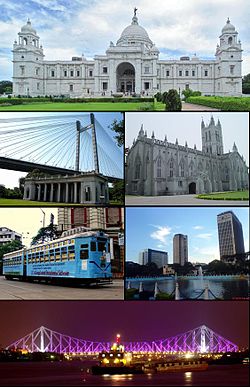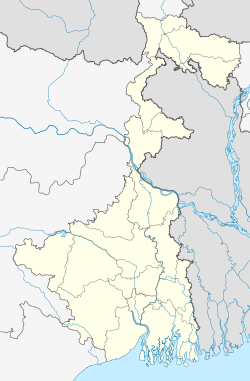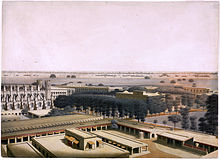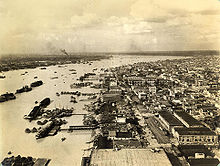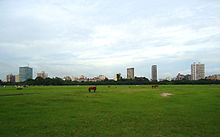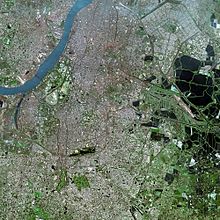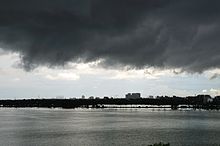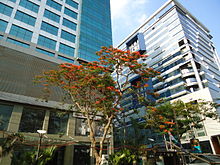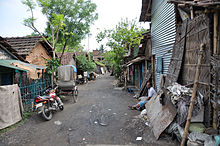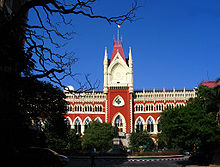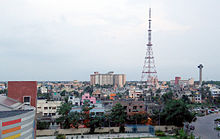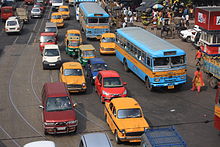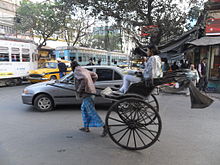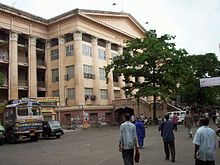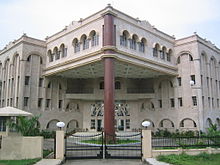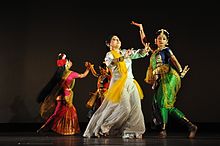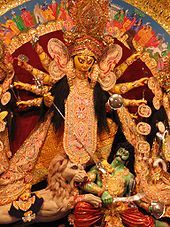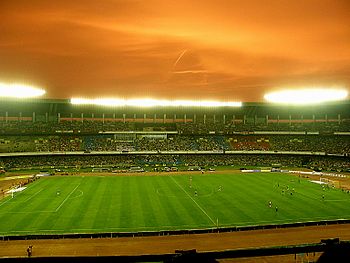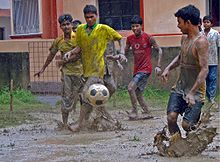
Kolkata
Background Information
This Schools selection was originally chosen by SOS Children for schools in the developing world without internet access. It is available as a intranet download. To compare sponsorship charities this is the best sponsorship link.
| Kolkata Calcutta |
|
|---|---|
| — City — | |
| Clockwise from top: Victoria Memorial, St. Paul's Cathedral, central business district, Howrah Bridge, city tram line, Vidyasagar Bridge | |
| Nickname(s): City of Joy | |
|
|
|
| Coordinates: 22.567°N 88.367°E Coordinates: 22.567°N 88.367°E | |
| Country | India |
| State | West Bengal |
| Division | Presidency |
| District | Kolkata |
| Government | |
| • Type | Mayor–Council |
| • Body | KMC |
| • Mayor | Sovan Chatterjee |
| • Sheriff | Indrajit Ray |
| • Police commissioner | Surajit Kar Purakayastha |
| Area | |
| • City | 185 km2 (71 sq mi) |
| • Metro | 1,886.67 km2 (728.45 sq mi) |
| Elevation | 9 m (30 ft) |
| Population (2011) | |
| • City | 4,486,679 |
| • Rank | 7th |
| • Density | 24,000/km2 (63,000/sq mi) |
| • Metro | 14,112,536 |
| • Metro rank | 3rd |
| • Metropolitan | 14,617,882 ( 3rd) |
| Demonym | Calcuttan |
| Time zone | IST ( UTC+05:30) |
| ZIP code(s) | 7000 xx, 7001 xx |
| Area code(s) | +91-33 |
| Vehicle registration | WB 01–79 |
| UN/LOCODE | IN CCU |
| Spoken languages | Bengali, English, Hindi, Urdu |
| Ethnicity | Bengali, Marwari, Bihari, Other |
| Website | www.kmcgov.in |
|
|
Kolkata / k ɒ l ˈ k æ t ə /, or Calcutta / k æ l ˈ k ʌ t ə /, is the capital of the Indian state of West Bengal. Located on the east bank of the Hooghly river, it is the principal commercial, cultural, and educational centre of East India, while the Port of Kolkata is India's oldest operating port as well as its sole major riverine port. As of 2011, the city had 4.5 million residents; the urban agglomeration, which comprises the city and its suburbs, was home to approximately 14.1 million, making it the third-most populous metropolitan area in India. As of 2008, its economic output as measured by gross domestic product ranked third among South Asian cities, behind Mumbai and Delhi. As a growing metropolitan city in a developing country, Kolkata confronts substantial urban pollution, traffic congestion, poverty, overpopulation, and other logistic and socioeconomic problems.
In the late 17th century, the three villages that predated Kolkata were ruled by the Nawab of Bengal under Mughal suzerainty. After the Nawab granted the East India Company a trading license in 1690, the area was developed by the Company into an increasingly fortified mercantile base. Nawab Siraj ud-Daulah occupied Kolkata in 1756, and the East India Company retook it in the following year and by 1772 assumed full sovereignty. Under East India Company and later under the British Raj, Kolkata served as the capital of India until 1911, when its perceived geographical disadvantages, combined with growing nationalism in Bengal, led to a shift of the capital to New Delhi. The city was a centre of the Indian independence movement; it remains a hotbed of contemporary state politics. Following Indian independence in 1947, Kolkata—which was once the centre of modern Indian education, science, culture, and politics—witnessed several decades of relative economic stagnation. Since the early 2000s, an economic rejuvenation has led to accelerated growth.
As a nucleus of the 19th- and early 20th-century Bengal Renaissance and a religiously and ethnically diverse centre of culture in Bengal and India, Kolkata has established local traditions in drama, art, film, theatre, and literature that have gained wide audiences. Many people from Kolkata—among them several Nobel laureates—have contributed to the arts, the sciences, and other areas, while Kolkata culture features idiosyncrasies that include distinctively close-knit neighbourhoods (paras) and freestyle intellectual exchanges (adda). West Bengal's share of the Bengali film industry is based in the city, which also hosts venerable cultural institutions of national importance, such as the Academy of Fine Arts, the Victoria Memorial, the Asiatic Society, the Indian Museum, and the National Library of India. Though home to major cricketing venues and franchises, Kolkata differs from other Indian cities by giving importance to association football and other sports.
Etymology
The word Kolkata derives from the Bengali term Kolikata [ˈkolikat̪a] (কলিকাতা), the name of one of three villages that predated the arrival of the British, in the area where the city eventually was to be established; the other two villages were Sutanuti and Govindapur. The term Kolikata is thought to be a variation of Kalikkhetro [ˈkalikʰːet̪ro] (Bengali: কালীক্ষেত্র), meaning "Field of [the goddess] Kali". Alternatively, the name may have been derived from the Bengali term kilkila (Bengali: কিলকিলা), or "flat area". The name may have its origin in the words khal [ˈkʰal] (Bengali: খাল) meaning "canal", followed by kaṭa [ˈkata] (Bengali: কাটা), which may mean "dug". According to another theory, the area specialised in the production of quicklime or koli chun [ˈkolitɕun] (Bengali: কলি চুন) and coir or kata [ˈkat̪a] (Bengali: কাতা); hence, it was called Kolikata [ˈkolikat̪a] (Bengali: কলিকাতা). While the city's name has always been pronounced Kolkata [ˈkolkat̪a] (Bengali: কলকাতা) or Kolikata [ˈkolikat̪a] (Bengali: কলিকাতা) in Bengali, the anglicised form Calcutta was the official name until 2001, when it was changed to Kolkata in order to match Bengali pronunciation.
History
The discovery and archaeological study of Chandraketugarh, 35 kilometres (22 mi) north of Kolkata, provide evidence that the region in which the city stands has been inhabited for over two millennia. Kolkata's recorded history began in 1690 with the arrival of the English East India Company, which was consolidating its trade business in Bengal. Job Charnock, an administrator who worked for the Company, is traditionally credited as the founder of the city; in response to a public petition, the Calcutta High Court ruled in 2003 that the city does not have a founder. The area occupied by the present-day city encompassed three villages: Kalikata, Gobindapur, and Sutanuti. Kalikata was a fishing village; Sutanuti was a riverside weavers' village. They were part of an estate belonging to the Mughal emperor; the jagirdari (a land grant bestowed by a king on his noblemen) taxation rights to the villages were held by the Sabarna Roy Choudhury family of landowners, or zamindars. These rights were transferred to the East India Company in 1698.
In 1712, the British completed the construction of Fort William, located on the east bank of the Hooghly River. Facing frequent skirmishes with French forces, the British began to upgrade their fortifications in 1756. The Nawab of Bengal, Siraj ud-Daulah, protested the militarisation. His warning went unheeded, and the Nawab attacked; he captured Fort William and instigated the gruesome killings of British prisoners of war in the Black Hole of Calcutta. A force of Company soldiers ( sepoys) and British troops led by Robert Clive recaptured the city the following year. Declared a presidency city, Calcutta became the headquarters of the Bengal Presidency. Calcutta was named the capital of East India Company controlled territories of India in 1772; beginning in 1864, the hill station of Shimla served as administrative capital during summers. In the early 19th century, the marshes surrounding the city were drained; the government area was laid out along the banks of the Hooghly River. Richard Wellesley, Governor-General of India between 1797 and 1805, was largely responsible for the development of the city and its public architecture. Throughout the late 18th and 19th century, the city was a centre of the East India Company's opium trade.
By the 1850s, Kolkata had two areas: White Town, which was primarily British and centred around Chowringhee; and Black Town, mainly Indian and centred around North Calcutta. The city underwent rapid industrial growth starting in the early 1850s, especially in the textile and jute industries; this encouraged British companies to massively invest in infrastructure projects, which included telegraph connections and Howrah railway station. The coalescence of British and Indian culture resulted in the emergence of a new babu class of urbane Indians, whose members were often bureaucrats, professionals, newspaper readers, and Anglophiles; they usually belonged to upper-caste Hindu communities. In the 19th century, the Bengal Renaissance brought about an increased sociocultural sophistication among city denizens. In 1883, Kolkata was host to the first national conference of the Indian National Association, the first avowed nationalist organisation in India. Gradually, Calcutta became a centre for revolutionary organisations associated with the Indian independence movement. The temporary 1905 partition of Bengal along communal lines resulted in widespread public agitation and a boycott of British goods by the Swadeshi movement. These activities, along with the administratively disadvantageous location of Calcutta on the eastern fringes of India, prompted the British to move the capital to New Delhi in 1911.
The city and its port were bombed several times by the Japanese between 1942 and 1944, during World War II. Coinciding with the war, millions starved to death during the Bengal famine of 1943 due to a combination of military, administrative, and natural factors. Demands for the creation of a Muslim state led in 1946 to an episode of communal violence that killed over 4,000. The partition of India led to further clashes and a demographic shift—many Muslims left for East Pakistan, while hundreds of thousands of Hindus fled into the city.
During the 1960s and 1970s, severe power shortages, strikes, and a violent Marxist–Maoist movement by groups known as the Naxalites damaged much of the city's infrastructure, resulting in economic stagnation. The Bangladesh Liberation War of 1971 led to a massive influx of thousands of refugees, many of them penniless, that strained Kolkata's infrastructure. During the mid-1980s, Mumbai (then called Bombay) overtook Kolkata as India's most populous city. In 1985, Rajiv Gandhi dubbed Kolkata a "dying city" in light of its socio-political woes.
In the period 1977–2011, West Bengal was governed from Kolkata by the Left Front, which was dominated by the Communist Party of India (CPM). It was the world's longest-serving democratically elected communist government; Kolkata was a key base for Indian communism. The city's economic recovery gathered momentum after the 1990s, when India began to institute pro-market reforms. Since 2000, the information technology (IT) services sector has revitalised Kolkata’s stagnant economy. The city is also experiencing marked growth in its manufacturing base.
Geography
Spread roughly north–south along the east bank of the Hooghly River, Kolkata sits within the lower Ganges Delta of eastern India; the city's elevation is 1.5–9 m (5–30 ft). Much of the city was originally a wetland that was reclaimed over the decades to accommodate a burgeoning population. The remaining undeveloped areas, known as the East Kolkata Wetlands, were designated a "wetland of international importance" by the Ramsar Convention (1975). As with most of the Indo-Gangetic Plain, the soil and water are predominantly alluvial in origin. Kolkata is located over the "Bengal basin", a pericratonic tertiary basin. Bengal basin comprises three structural unit: shelf or platform in the west; central hinge or shelf/slope break; and deep basinal part in the east and southeast. Kolkata is located atop the western part of the hinge zone which is about 25 km (16 mi) wide at a depth of about 45,000 m (148,000 ft) below the surface. The shelf and hinge zones have many faults, among them some are active. Total thickness of sediment below Kolkata is nearly 7,500 m (24,600 ft) above the crystalline basement; of these the top 350–450 m (1,150–1,480 ft) is quaternary, followed by 4,500–5,500 m (14,760–18,040 ft) of tertiary sediments, 500–700 m (1,640–2,300 ft) trap wash of cretaceous trap and 600–800 m (1,970–2,620 ft) permian-carboniferous Gondwana rocks. The quaternary sediments consist of clay, silt, and several grades of sand and gravel. These sediments are sandwiched between two clay beds: the lower one at a depth of 250–650 m (820–2,130 ft); the upper one 10–40 m (30–130 ft) in thickness. According to the Bureau of Indian Standards, on a scale ranging from I to V in order of increasing susceptibility to earthquakes, the city lies inside seismic zone III; according to a United Nations Development Programme report, its wind and cyclone zone is "very high damage risk".
Urban structure
The Kolkata metropolitan area is spread over 1,886.67 km2 (728.45 sq mi) and comprises 3 municipal corporations (including Kolkata Municipal Corporation), 39 local municipalities and 24 panchayat samitis, as of 2011. The urban agglomeration encompassed 72 cities and 527 towns and villages, as of 2006. Suburban areas in the Kolkata metropolitan area incorporate parts of the following districts: North 24 Parganas, South 24 Parganas, Howrah, Hooghly, and Nadia. Kolkata, which is under the jurisdiction of the Kolkata Municipal Corporation ( KMC), has an area of 185 km2 (71 sq mi). The east–west dimension of the city is comparatively narrow, stretching from the Hooghly River in the west to roughly the Eastern Metropolitan Bypass in the east—a span of 9–10 km (5.6–6.2 mi). The north–south distance is greater, and its axis is used to section the city into North, Central, and South Kolkata.
North Kolkata is the oldest part of the city. Characterised by 19th-century architecture and narrow alleyways, it includes areas such as Shyambazar, Shobhabazar, Chitpur, Cossipore, Baranagar, Sinthee, and Dum Dum. Central Kolkata hosts the central business district. It contains B. B. D. Bagh, formerly known as Dalhousie Square, and the Esplanade on its east; Strand Road is on its west. The West Bengal Secretariat, General Post Office, Reserve Bank of India, High Court, Lalbazar Police Headquarters, and several other government and private offices are located there. Another business hub is the area south of Park Street, which comprises thoroughfares such as Jawaharlal Nehru Road, Camac Street, Wood Street, Loudon Street, Shakespeare Sarani, and A. J. C. Bose Road. The Maidan is a large open field in the heart of the city that has been called the "lungs of Kolkata" and accommodates sporting events and public meetings. The Victoria Memorial and Kolkata Race Course are located at the southern end of the Maidan. Among the other parks are Central Park in Bidhannagar and Millennium Park on Strand Road, along the Hooghly River.
South Kolkata developed after India gained independence in 1947; it includes upscale neighbourhoods such as Ballygunge, Alipore, New Alipore, Lansdowne, Bhowanipore, Tollygunge, Jodhpur Park, Lake Gardens, Golf Green, Jadavpur, and Kasba. From south-west to south-east, outlying areas include Garden Reach, Behala, Thakurpukur, Kudghat, Ranikuthi, Bansdroni, Baghajatin, and Garia. Two planned townships in the greater Kolkata region are Bidhannagar, also known as Salt Lake City and located north-east of the city; and Rajarhat, also called New Town and sited east of Bidhannagar. In the 2000s, Sector V in Bidhannagar developed into a business hub for information technology and telecommunication companies. Both Bidhannagar and New Town are situated outside the Kolkata Municipal Corporation limits, in their own municipalities. Fort William, on the western part of the city, houses the headquarters of the Eastern Command of the Indian Army; its premises are under the jurisdiction of the army.
Climate
Kolkata is subject to a tropical wet-and-dry climate that is designated Aw under the Köppen climate classification. The annual mean temperature is 26.8 °C (80.2 °F); monthly mean temperatures are 19–30 °C (66–86 °F). Summers (March–June) are hot and humid, with temperatures in the low 30s Celsius; during dry spells, maximum temperatures often exceed 40 °C (104 °F) in May and June. Winter lasts for only about two-and-a-half months, with seasonal lows dipping to 9–11 °C (48–52 °F) in December and January. May is the hottest month, with daily temperatures ranging from 27–37 °C (81–99 °F); January, the coldest month, has temperatures varying from 12–23 °C (54–73 °F). The highest recorded temperature is 43.9 °C (111.0 °F), and the lowest is 5 °C (41 °F). Often, in April–June, the city is struck by heavy rains or dusty squalls followed by thunderstorms or hailstorms, bringing cooling relief from the prevailing humidity. These thunderstorms are convective in nature, and are known locally as kal baisakhi (কালবৈশাখী), or "Nor'westers" in English.
Rains brought by the Bay of Bengal branch of the south-west summer monsoon lash Kolkata between June and September, supplying it with most of its annual rainfall of 1,582 mm (62 in). The highest monthly rainfall total, 306 mm (12 in), occurs in August. The city receives 2,528 hours of sunshine per year, with maximum sunlight exposure occurring in March. Kolkata has been hit by several cyclones; these include systems occurring in 1737 and 1864 that killed thousands.
Pollution is a major concern in Kolkata. As of 2008, sulphur dioxide and nitrogen dioxide annual concentration were within the national ambient air quality standards of India, but respirable suspended particulate matter levels were high, and on an increasing trend for five consecutive years, causing smog and haze. Severe air pollution in the city has caused a rise in pollution-related respiratory ailments, such as lung cancer.
| Climate data for Kolkata (1971–1990) | |||||||||||||
|---|---|---|---|---|---|---|---|---|---|---|---|---|---|
| Month | Jan | Feb | Mar | Apr | May | Jun | Jul | Aug | Sep | Oct | Nov | Dec | Year |
| Record high °C (°F) | 32.6 (90.7) |
36.4 (97.5) |
39.4 (102.9) |
41.5 (106.7) |
43.3 (109.9) |
43.0 (109.4) |
39.7 (103.5) |
35.5 (95.9) |
36.2 (97.2) |
35.3 (95.5) |
34.3 (93.7) |
32.3 (90.1) |
43.3 (109.9) |
| Average high °C (°F) | 26.4 (79.5) |
29.1 (84.4) |
33.5 (92.3) |
35.3 (95.5) |
35.4 (95.7) |
34.0 (93.2) |
32.3 (90.1) |
32.1 (89.8) |
32.4 (90.3) |
32.3 (90.1) |
30.3 (86.5) |
27.0 (80.6) |
31.7 (89.1) |
| Daily mean °C (°F) | 20.1 (68.2) |
23.0 (73.4) |
27.6 (81.7) |
30.2 (86.4) |
30.7 (87.3) |
30.3 (86.5) |
29.2 (84.6) |
29.1 (84.4) |
29.1 (84.4) |
28.2 (82.8) |
24.9 (76.8) |
20.8 (69.4) |
26.93 (80.49) |
| Average low °C (°F) | 13.8 (56.8) |
16.9 (62.4) |
21.7 (71.1) |
25.1 (77.2) |
26.0 (78.8) |
26.5 (79.7) |
26.1 (79) |
26.1 (79) |
25.8 (78.4) |
23.9 (75) |
19.6 (67.3) |
14.5 (58.1) |
22.2 (72) |
| Record low °C (°F) | 8.2 (46.8) |
8.1 (46.6) |
12.7 (54.9) |
16.1 (61) |
19.6 (67.3) |
21.4 (70.5) |
23.1 (73.6) |
22.7 (72.9) |
22.7 (72.9) |
18.7 (65.7) |
12.0 (53.6) |
9.7 (49.5) |
8.1 (46.6) |
| Rainfall mm (inches) | 11 (0.43) |
30 (1.18) |
35 (1.38) |
60 (2.36) |
142 (5.59) |
288 (11.34) |
411 (16.18) |
349 (13.74) |
288 (11.34) |
143 (5.63) |
26 (1.02) |
17 (0.67) |
1,800 (70.86) |
| Avg. rainy days (≥ 1.0 mm) | 1.2 | 2.2 | 3.0 | 4.8 | 8.7 | 14.7 | 20.5 | 20.2 | 15.7 | 8.1 | 1.5 | 0.9 | 101.5 |
| % humidity | 66 | 58 | 58 | 66 | 70 | 77 | 83 | 83 | 81 | 73 | 67 | 68 | 70.8 |
| Mean monthly sunshine hours | 204.6 | 203.4 | 226.3 | 234.0 | 226.3 | 123.0 | 93.0 | 105.4 | 117.0 | 182.9 | 192.0 | 204.6 | 2,112.5 |
| Source: Hong Kong Observatory, NOAA (extremes, mean, humidity, 1971-1990) | |||||||||||||
Economy
Kolkata is the main commercial and financial hub of East and North-East India and home to the Calcutta Stock Exchange. It is a major commercial and military port, and is the only city in eastern India to have an international airport. Once India's leading city, Kolkata experienced a steady economic decline in the decades following India's independence due to steep population increases and a rise in militant trade-unionism, which included frequent strikes that were backed by left-wing parties. From the 1960s to the late 1990s, several factories were closed and businesses relocated. The lack of capital and resources added to the depressed state of the city's economy and gave rise to an unwelcome sobriquet: the "dying city". The city's fortunes improved after the Indian economy was liberalised in the 1990s and changes in economic policy were enacted by the West Bengal state government.
Flexible production has been the norm in Kolkata, which has an informal sector that employs more than 40% of the labour force. One unorganised group, roadside hawkers, generated business worth ![]() 8,772 crore (US$ 2 billion) in 2005. As of 2001, around 0.81% of the city's workforce was employed in the primary sector (agriculture, forestry, mining, etc.); 15.49% worked in the secondary sector (industrial and manufacturing); and 83.69% worked in the tertiary sector (service industries). As of 2003, the majority of households in slums were engaged in occupations belonging to the informal sector; 36.5% were involved in servicing the urban middle class (as maids, drivers, etc.), and 22.2% were casual labourers. About 34% of the available labour force in Kolkata slums were unemployed. As in many other Indian cities, information technology became a high-growth sector in Kolkata starting in the late 1990s; the city's IT sector grew at 70% per annum—a rate that was twice the national average. The 2000s saw a surge of investments in the real estate, infrastructure, retail, and hospitality sectors; several large shopping malls and hotels were launched. As of 2010, Kolkata, with an estimated gross domestic product (GDP) by purchasing power parity of 150 billion dollars, ranked third among South Asian cities, after Mumbai and Delhi.
8,772 crore (US$ 2 billion) in 2005. As of 2001, around 0.81% of the city's workforce was employed in the primary sector (agriculture, forestry, mining, etc.); 15.49% worked in the secondary sector (industrial and manufacturing); and 83.69% worked in the tertiary sector (service industries). As of 2003, the majority of households in slums were engaged in occupations belonging to the informal sector; 36.5% were involved in servicing the urban middle class (as maids, drivers, etc.), and 22.2% were casual labourers. About 34% of the available labour force in Kolkata slums were unemployed. As in many other Indian cities, information technology became a high-growth sector in Kolkata starting in the late 1990s; the city's IT sector grew at 70% per annum—a rate that was twice the national average. The 2000s saw a surge of investments in the real estate, infrastructure, retail, and hospitality sectors; several large shopping malls and hotels were launched. As of 2010, Kolkata, with an estimated gross domestic product (GDP) by purchasing power parity of 150 billion dollars, ranked third among South Asian cities, after Mumbai and Delhi.
Kolkata is home to many industrial units operated by large public- and private-sector corporations; major sectors include steel, heavy engineering, mining, minerals, cement, pharmaceuticals, food processing, agriculture, electronics, textiles, and jute. ITC Limited, Coal India Limited, and Britannia Industries rank among the companies headquartered in the city. Kolkata hosts the headquarters of three major public-sector banks: Allahabad Bank, UCO Bank, and the United Bank of India. Adoption of the "Look East" policy by the Indian government; opening of Sikkim's Nathu La mountain pass, which is located on the border between India and China, to bi-directional international trade; and the interest shown by South-East Asian countries in expanding into Indian markets are factors that could benefit Kolkata.
Demographics
A resident of Kolkata is referred to via the demonym Calcuttan or Kolkatan. According to provisional results of the 2011 national census, Kolkata district, which occupies an area of 185 km2 (71 sq mi), had a population of 4,486,679; its population density was 24,252 /km2 (62,810 /sq mi). This represents a decline of 1.88% during the decade 2001–11. The sex ratio is 899 females per 1000 males—lower than the national average. The ratio is depressed by the influx of working males from surrounding rural areas, from the rest of West Bengal, and from neighbouring states, mainly Bihar, Uttar Pradesh, and Orissa; these men commonly leave their families behind. Kolkata's literacy rate of 87.14% exceeds the all-India average of 74%. The urban agglomeration had a population of 14,112,536 in 2011.
Bengali people form the majority of Kolkata's population; Marwaris and Biharis compose large minorities. Among Kolkata's smaller communities are Chinese, Tamils, Nepalis, Oriyas, Telugus, Assamese, Gujaratis, Anglo-Indians, Armenians, Greeks, Tibetans, Maharashtrians, Konkanis, Malayalees, Punjabis, and Parsis. The number of Armenians, Greeks, Jews, and other foreign-origin groups declined during the 20th century—in the case of the Jewish population, after the establishment of Israel in 1948. India's sole Chinatown is in eastern Kolkata; once home to 20,000 ethnic Chinese, its population dropped to around 2,000 as of 2009 as a result of multiple factors including repatriation and denial of Indian citizenship following the 1962 Sino-Indian War, and immigration to foreign countries for better economic opportunities. The Chinese community traditionally worked in the local tanning industry and ran Chinese restaurants.
| Census | Total | %± |
|---|---|---|
| 1981 | 9,194,000 | — |
| 1991 | 11,021,900 | 19.9% |
| 2001 | 13,114,700 | 19.0% |
| 2011 | 14,112,536 | 7.6% |
| Source: Census of India | ||
Bengali, the official state language, is the dominant language in Kolkata. English is also used, particularly by the white-collar workforce. Hindi and Urdu are spoken by a sizeable minority. According to the 2001 census, 77.68% of the population is Hindu, 20.27% Muslim, 0.88% Christian, and 0.46% Jain. The remainder of the population includes Sikhs, Buddhists, and other religions; 0.19% did not state a religion in the census. Kolkata reported 67.6% of Special and Local Laws crimes registered in 35 large Indian cities during 2004. The Kolkata police district registered 15,510 Indian Penal Code cases in 2010, the 8th-highest total in the country. In 2010, the crime rate was 117.3 per 100,000, below the national rate of 187.6; it was the lowest rate among India's largest cities.
As of 2003, about one-third of the population, or 1.5 million people, lived in 3,500 unregistered squatter-occupied and 2,011 registered slums. The authorised slums (with access to basic services like water, latrines, trash removal by the Kolkata Municipal Corporation) can be broadly divided into two groups—bustees, in which slum dwellers have some long term tenancy agreement with the landowners; and udbastu colonies, settlements which had been leased to refugees from present-day Bangladesh by the Government. The unauthorised slums (devoid of basic services provided by the municipality) are occupied by squatters who started living on encroached lands—mainly along canals, railway lines and roads. According to the 2005 National Family Health Survey, around 14% of the households in Kolkata were poor, while 33% lived in slums, indicating a substantial proportion of households in slum areas were better off economically than the bottom quarter of urban households in terms of wealth status. Mother Teresa was awarded the Nobel Peace Prize for founding and working with the Missionaries of Charity in Kolkata—an organisation "whose primary task was to love and care for those persons nobody was prepared to look after".
Government and public services
Civic administration
Kolkata is administered by several government agencies. The Kolkata Municipal Corporation, or KMC, oversees and manages the civic infrastructure of the city's 15 boroughs, which together encompass 141 wards. Each ward elects a councillor to the KMC. Each borough has a committee of councillors, each of whom is elected to represent a ward. By means of the borough committees, the corporation undertakes urban planning and maintains roads, government-aided schools, hospitals, and municipal markets. As Kolkata's apex body, the corporation discharges its functions through the mayor-in-council, which comprises a mayor, a deputy mayor, and ten other elected members of the KMC. The functions of the KMC include water supply, drainage and sewerage, sanitation, solid waste management, street lighting, and building regulation. The Kolkata Port Trust, an agency of the central government, manages the city's river port. As of 2012, the All India Trinamool Congress controls the KMC; the mayor is Sovan Chatterjee, while the deputy mayor is Farzana Alam. The city has an apolitical titular post, that of the Sheriff of Kolkata, which presides over various city-related functions and conferences.
Kolkata's administrative agencies have areas of jurisdiction that do not coincide. Listed in ascending order by area, they are: Kolkata district; the Kolkata Police area and the Kolkata Municipal Corporation area, or "Kolkata city"; and the Kolkata metropolitan area, which is the city's urban agglomeration. The agency overseeing the latter, the Kolkata Metropolitan Development Authority, is responsible for the statutory planning and development of greater Kolkata.
As the seat of the Government of West Bengal, Kolkata is home to not only the offices of the local governing agencies, but also the West Bengal Legislative Assembly; the state secretariat, which is housed in the Writers' Building; and the Calcutta High Court. Kolkata has lower courts: the Court of Small Causes and the City Civil Court decide civil matters; the Sessions Court rules in criminal cases. The Kolkata Police, headed by a police commissioner, is overseen by the West Bengal Ministry of Home Affairs. The Kolkata district elects two representatives to India's lower house, the Lok Sabha, and 11 representatives to the state legislative assembly.
Utility services
The Kolkata Municipal Corporation supplies the city with potable water that is sourced from the Hooghly River; most of it is treated and purified at the Palta pumping station located in North 24 Parganas district. Roughly 95% of the 4,000 tonnes of refuse produced daily by the city is transported to the dumping grounds in Dhapa, which is east of the town. To promote the recycling of garbage and sewer water, agriculture in encouraged on the dumping grounds. Parts of the city lack proper sewerage, leading to unsanitary methods of waste disposal.
Electricity is supplied by the privately operated Calcutta Electric Supply Corporation, or CESC, to the city proper; the West Bengal State Electricity Board supplies it in the suburbs. Fire services are handled by the West Bengal Fire Service, a state agency. As of 2012, the city had 16 fire stations.
State-owned Bharat Sanchar Nigam Limited, or BSNL, as well as private enterprises, among them Vodafone, Bharti Airtel, Reliance, Idea Cellular, Aircel, Tata DoCoMo, Tata Teleservices, Virgin Mobile, and MTS India, are the leading telephone and cell phone service providers in the city. Kolkata being the first city in India to have cell phone and 4G connectivity, the GSM and CDMA cellular coverage is extensive. As of 2010, Kolkata has 7 percent of the total Broadband internet consumers in India; BSNL, VSNL, Tata Indicom, Sify, Airtel, and Reliance are among the main vendors.
Infrastructure
Transport
Public transport is provided by the Kolkata Suburban Railway, the Kolkata Metro, trams, and buses. The suburban rail network reaches the city's distant suburbs. The Kolkata Metro, in operation since 1984, is the oldest underground mass transit system in India. It spans the north–south length of the city and covers a distance of 25.1 km (16 mi). As of 2009, five Metro rail lines were under construction. Kolkata has three long-distance railway stations, located at Howrah, Sealdah, and Chitpur, which connect Kolkata by rail to most cities in West Bengal and to other major cities in India. The city serves as the headquarters of two Indian Railways regional divisions—the Eastern Railway and the South-Eastern Railway.
Kolkata has rail and road connectivity with Dhaka, capital of Bangladesh.
Buses, which are the most commonly used mode of transport, are run by government agencies and private operators. Kolkata is the only Indian city with a tram network, which is operated by the Calcutta Tramways Company. The slow-moving tram services are restricted to certain areas of the city. Water-logging, caused by heavy rains that fall during the summer monsoon, can interrupt transportation networks. Hired public conveyances include auto rickshaws, which often ply specific routes, and yellow metered taxis. Almost all of Kolkata's taxis are antiquated Hindustan Ambassadors by make; newer air-conditioned radio taxis are also in service. In parts of the city, cycle rickshaws and hand-pulled rickshaws are patronised by the public for short trips.
Due to its diverse and abundant public transportation, privately owned vehicles are not as common in Kolkata as in other major Indian cities. The city has witnessed a steady increase in the number of registered vehicles; 2002 data showed an increase of 44% over a period of seven years. As of 2004, after adjusting for population density, the city's "road space" was only 6% compared to 23% in Delhi and 17% in Mumbai. The Kolkata Metro has somewhat eased traffic congestion, as has the addition of new roads and flyovers. Agencies operating long-distance bus services include Calcutta State Transport Corporation, South Bengal State Transport Corporation, North Bengal State Transport Corporation, and various private operators. The city's main bus terminals are located at Esplanade, Karunamoyee, and Babughat. The Kolkata–Delhi and Kolkata–Chennai prongs of the Golden Quadrilateral, and National Highway 34 start from the city.
Netaji Subhas Chandra Bose International Airport, located in Dum Dum some 16 km (9.9 mi) north-east of the city centre, operates domestic and international flights. In 2013, the airport was upgraded to handle increased air traffic.
The Port of Kolkata, established in 1870, is India's oldest and the only major river port. The Kolkata Port Trust manages docks in Kolkata and Haldia. The port hosts passenger services to Port Blair, capital of the Andaman and Nicobar Islands; freighter service to ports throughout India and around the world is operated by the Shipping Corporation of India. Ferry services connect Kolkata with its twin city of Howrah, located across the Hooghly River.
Healthcare
As of 2011, the health care system in Kolkata consists of 48 government hospitals, mostly under the Department of Health & Family Welfare, Government of West Bengal, and 366 private medical establishments; these establishments provide the city with 27,687 hospital beds. For every 10,000 people in the city, there are 61.7 hospital beds, which is higher than the national average of 9 hospital beds per 10,000. Ten medical and dental colleges are located in the Kolkata metropolitan area which act as tertiary referral hospitals in the state. Calcutta Medical College, founded in 1835, was the first institution in Asia to teach modern medicine. These facilities are inadequate to meet the healthcare needs of the city. More than 78% in Kolkata prefer the private medical sector over the public medical sector, due to the poor quality of care, the lack of a nearby facility, and excessive waiting times at government facilities.
According to the 2005 National Family Health Survey, only a small proportion of Kolkata households were covered under any health scheme or health insurance. The total fertility rate in Kolkata was 1.4, which was the lowest among the eight cities surveyed. In Kolkata, 77% of the married women used contraceptives, which was the highest among the cities surveyed, but use of modern contraceptive methods was the lowest (46%). The infant mortality rate in Kolkta was 41 per 1,000 live births, and the mortality rate for children under five was 49 per 1,000 live births.
Among the surveyed cities, Kolkata stood second (5%) for children who had not had any vaccinations under the Universal Immunization Programme as of 2005. Kolkata ranked second among the surveyed cities, with access to an anganwadi centre under the Integrated Child Development Services (ICDS) programme for 57% of the children between 0 and 71 months. The proportion of malnourished, anaemic and underweight children in Kolkata was less in comparison to other surveyed cities.
About 30% of the women and 18% of the men in Kolkata are obese—the majority of them belonging to the non-poor strata of society. In 2005, Kolkata had the highest percentage (55%) among the surveyed cities of anaemic woman, while 20% of the men in Kolkata were anaemic. Diseases like diabetes, asthma, goitre and other thyroid disorders were found in large numbers of people. Tropical diseases like malaria, dengue and chikungunya are prevalent in Kolkata, though their incidence is decreasing. Kolkata is one of the districts in India with a high number of people with AIDS; it has been designated a district prone to high risk.
Education
Kolkata's schools are run by the state government or private organisations, many of which are religious. Bengali and English are the primary languages of instruction; Urdu and Hindi are also used, particularly in central Kolkata. Schools in Kolkata follow the "10+2+3" plan. After completing their secondary education, students typically enroll in schools that have a higher secondary facility and are affiliated with the West Bengal Council of Higher Secondary Education, the ICSE, or the CBSE. They usually choose a focus on liberal arts, business, or science. Vocational programs are also available.
As of 2010, the Kolkata urban agglomeration is home to 14 universities run by the state government. The colleges are each affiliated with a university or institution based either in Kolkata or elsewhere in India. The University of Calcutta, founded in 1857, is the oldest modern university in South Asia. Bengal Engineering and Science University is the 2nd oldest prestigious engineering institution of the country located in Howrah. Jadavpur University is known for its arts, science, and engineering faculties. The Indian Institute of Management Calcutta, which was the first of the Indian Institutes of Management, was established in 1961 at Joka, a locality in the south-western suburbs. The West Bengal National University of Juridical Sciences is one of India's autonomous law schools, while the Indian Statistical Institute is a public research institute and university.
Notable scholars who were born, worked or studied in Kolkata include physicists Satyendra Nath Bose, Meghnad Saha, and Jagadish Chandra Bose; chemist Prafulla Chandra Roy; statistician Prasanta Chandra Mahalanobis; physician Upendranath Brahmachari; educator Ashutosh Mukherjee; and Nobel laureates Rabindranath Tagore, C. V. Raman, and Amartya Sen.
Culture
Kolkata is known for its literary, artistic, and revolutionary heritage; as the former capital of India, it was the birthplace of modern Indian literary and artistic thought. Kolkata has been called the "City of Furious, Creative Energy" as well as the "cultural [or literary] capital of India". The presence of paras, which are neighbourhoods that possess a strong sense of community, is characteristic of Kolkata. Typically, each para has its own community club and, on occasion, a playing field. Residents engage in addas, or leisurely chats, that often take the form of freestyle intellectual conversation. The city has a tradition of political graffiti depicting everything from outrageous slander to witty banter and limericks, caricatures, and propaganda.
Kolkata has many buildings adorned with Indo-Islamic and Indo-Saracenic architectural motifs. Several well-maintained major buildings from the colonial period have been declared "heritage structures"; however, others are in various stages of decay. Established in 1814 as the nation's oldest museum, the Indian Museum houses large collections that showcase Indian natural history and Indian art. Marble Palace is a classic example of a European mansion that was built in the city. The Victoria Memorial, a place of interest in Kolkata, has a museum documenting the city's history. The National Library of India is the leading public library in the country.
The popularity of commercial theatres in the city has declined since the 1980s. Group theatres of Kolkata, a cultural movement that started in the 1940s contrasting with the then-popular commercial theatres, are theatres that are not professional or commercial, and are centres of various experiments in theme, content, and production; group theatres use the proscenium stage to highlight socially relevant messages. Chitpur locality of the city houses multiple production companies of jatra, a tradition of folk drama popular in rural Bengal. Kolkata is the home of the Bengali cinema industry, dubbed "Tollywood" for Tollygunj, where most of the state's film studios are located. Its long tradition of art films includes globally acclaimed film directors such as Academy Award-winning director Satyajit Ray, Ritwik Ghatak, Mrinal Sen, Tapan Sinha, and contemporary directors such as Aparna Sen, Buddhadeb Dasgupta, and Rituparno Ghosh.
During the 19th and 20th centuries, Bengali literature was modernised through the works of authors such as Ishwar Chandra Vidyasagar, Bankim Chandra Chattopadhyay, Michael Madhusudan Dutt, Rabindranath Tagore, Kazi Nazrul Islam, and Sarat Chandra Chattopadhyay. Coupled with social reforms led by Ram Mohan Roy, Swami Vivekananda, and others, this constituted a major part of the Bengal Renaissance. The middle and latter parts of the 20th century witnessed the arrival of post-modernism, as well as literary movements such as those espoused by the Kallol movement, hungryalists and the little magazines. Large majority of publishers of the city is concentrated in and around College Street, "...a half-mile of bookshops and bookstalls spilling over onto the pavement", selling new and used books.
Kalighat painting originated in 19th century Kolkata as a local style that reflected a variety of themes including mythology and quotidian life. The Government College of Art and Craft, founded in 1864, has been the cradle as well as workplace of eminent artists including Abanindranath Tagore, Jamini Roy, and Nandalal Bose. The art college was the birthplace of the Bengal school of art that arose as an avant garde and nationalist movement reacting against the prevalent academic art styles in the early 20th century. The Academy of Fine Arts and other art galleries hold regular art exhibitions. The city is recognised for its appreciation of rabindrasangeet (songs written by Rabindranath Tagore) and Indian classical music; Bengali popular music, including baul folk ballads, kirtans, and Gajan festival music; and modern music, including Bengali-language adhunik songs. Since the early 1990s, new genres have emerged, including one comprising alternative folk–rock Bengali bands. Another new style, jibonmukhi gaan ("songs about life"), is based on realism.
Key elements of Kolkata's cuisine include rice and a fish curry known as machher jhol, which can be accompanied by desserts such as roshogolla, sandesh, and a sweet yoghurt known as mishti dohi. Bengal's large repertoire of seafood dishes includes various preparations of ilish, a fish that is a favourite among Calcuttans. Street foods such as beguni (fried battered eggplant slices), kati roll (flatbread roll with vegetable or chicken, mutton, or egg stuffing), phuchka (a deep-fried crêpe with tamarind sauce) and Indian Chinese cuisine from Chinatown are popular. Sweets play a large part in the diet of Kolkatans—especially at their social ceremonies.
Though Bengali women traditionally wear the sari, the shalwar kameez and Western attire is gaining acceptance among younger women. Western-style dress has greater acceptance among men, although the traditional dhoti and kurta are seen during festivals. Durga Puja, held in September–October, is Kolkata's most important festival; it is an occasion for glamorous celebrations. The Bengali New Year, known as Poila Boishak, as well as the harvest festival of Poush Parbon are among the city's other festivals; also celebrated are Jagaddhatri Puja, Diwali, Saraswati Puja, Eid, Holi, Christmas, and Rath Yatra. Cultural events include the Kolkata Book Fair, the Dover Lane Music Festival, the Kolkata Film Festival, and Nandikar's National Theatre Festival.
Sports
The most popular sports in Kolkata are football and cricket. The city is a centre of football activity in India and is home to top national clubs such as Mohun Bagan A.C., Kingfisher East Bengal F.C., Prayag United S.C., and the Mohammedan Sporting Club. Calcutta Football League, which was started in 1898, is the oldest football league in Asia. Mohun Bagan A.C., one of the oldest football clubs in Asia, is the only organisation to be dubbed a "National Club of India". As in the rest of India, cricket is popular in Kolkata and is played on grounds and in streets throughout the city. Kolkata has an Indian Premier League franchise known as the Kolkata Knight Riders; the Cricket Association of Bengal, which regulates cricket in West Bengal, is also based in the city. Tournaments, especially those involving cricket, football, badminton, and carrom, are regularly organised on an inter-locality or inter-club basis. The Maidan, a vast field that serves as the city's largest park, hosts several minor football and cricket clubs and coaching institutes.
Eden Gardens, which has a capacity of 90,000 as of 2011, hosted the final match of the 1987 Cricket World Cup. It is home to the Bengal cricket team and the Kolkata Knight Riders. The multi-use Salt Lake Stadium, also known as Yuva Bharati Krirangan, is the world's second-largest football facility by seating capacity as of 2010. The Calcutta Cricket and Football Club is the second-oldest cricket club in the world. Kolkata has three 18-hole golf courses. The oldest is at the Royal Calcutta Golf Club, and was the first golf club to be built outside the United Kingdom. The other two are located at the Tollygunge Club and at Fort William. The Royal Calcutta Turf Club hosts horse racing and polo matches. The Calcutta Polo Club is considered the oldest extant polo club in the world. The Calcutta South Club is a venue for national and international tennis tournaments; it held the first grass-court national championship in 1946. In the period 2005–2007, Sunfeast Open, a tier-III tournament on the Women's Tennis Association circuit, was held in the Netaji Indoor Stadium; it has since been discontinued.
The Calcutta Rowing Club hosts rowing heats and training events. Kolkata, considered the leading centre of rugby union in India, gives its name to the oldest international tournament in rugby union, the Calcutta Cup. The Automobile Association of Eastern India, established in 1904, and the Bengal Motor Sports Club are involved in promoting motor sports and car rallies in Kolkata and West Bengal. The Beighton Cup, an event organised by the Bengal Hockey Association and first played in 1895, is India's oldest field hockey tournament; it is usually held on the Mohun Bagan Ground of the Maidan. Athletes from Kolkata include Sourav Ganguly and Pankaj Roy, who are former captains of the Indian national cricket team; Olympic tennis bronze medallist Leander Paes, golfer Arjun Atwal, and former footballers Sailen Manna, Chuni Goswami, P. K. Banerjee, and Subrata Bhattacharya.
